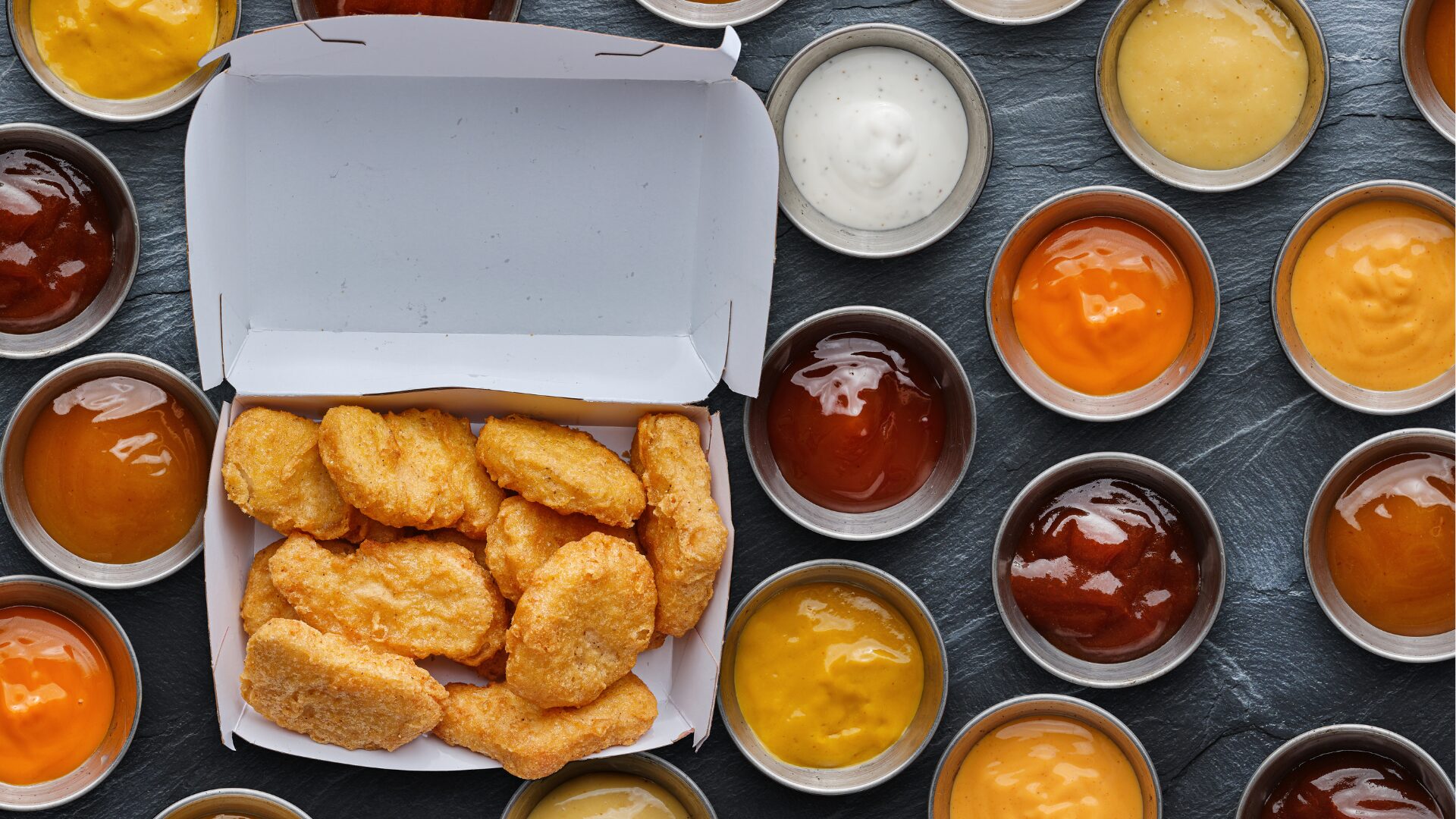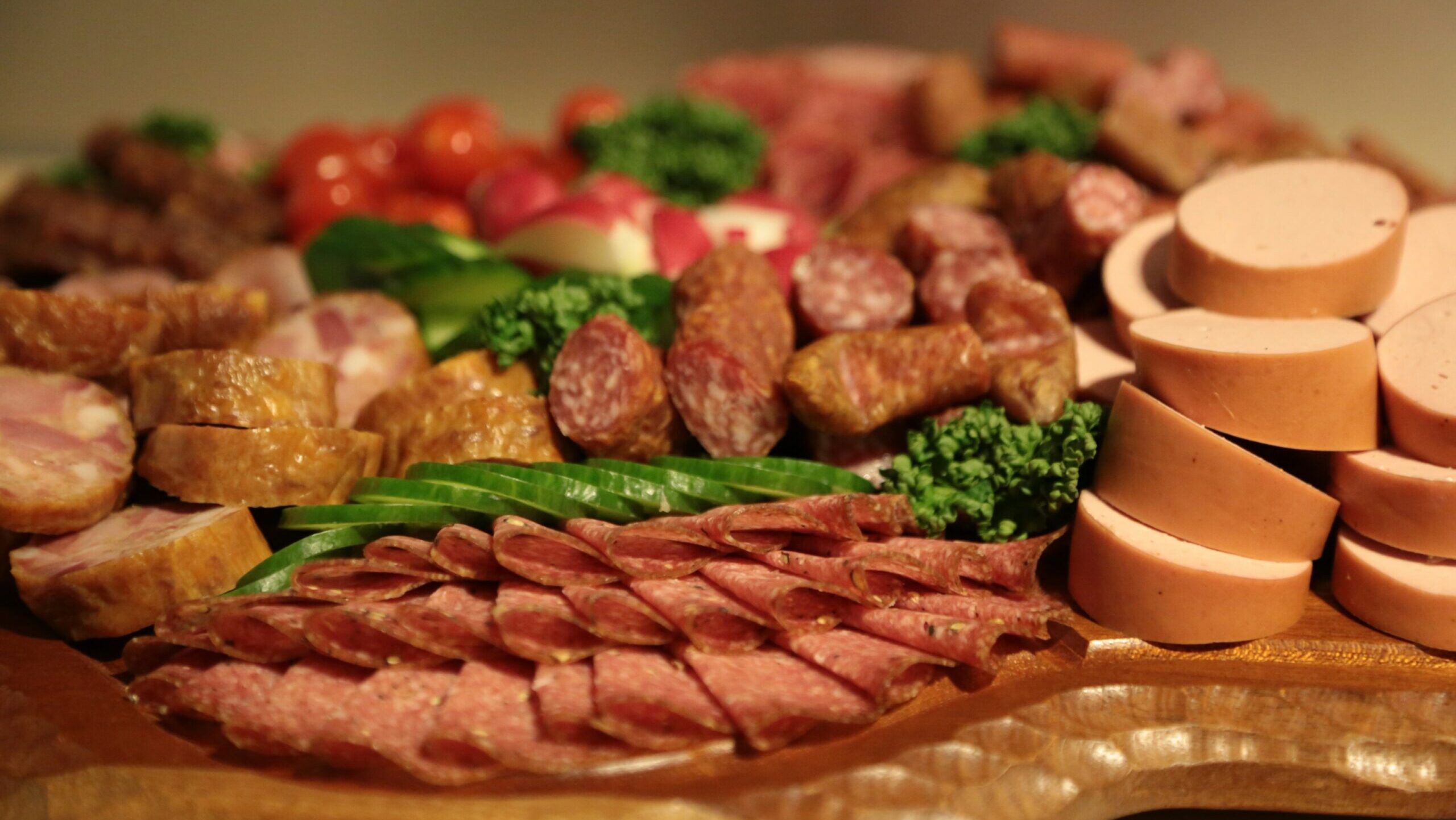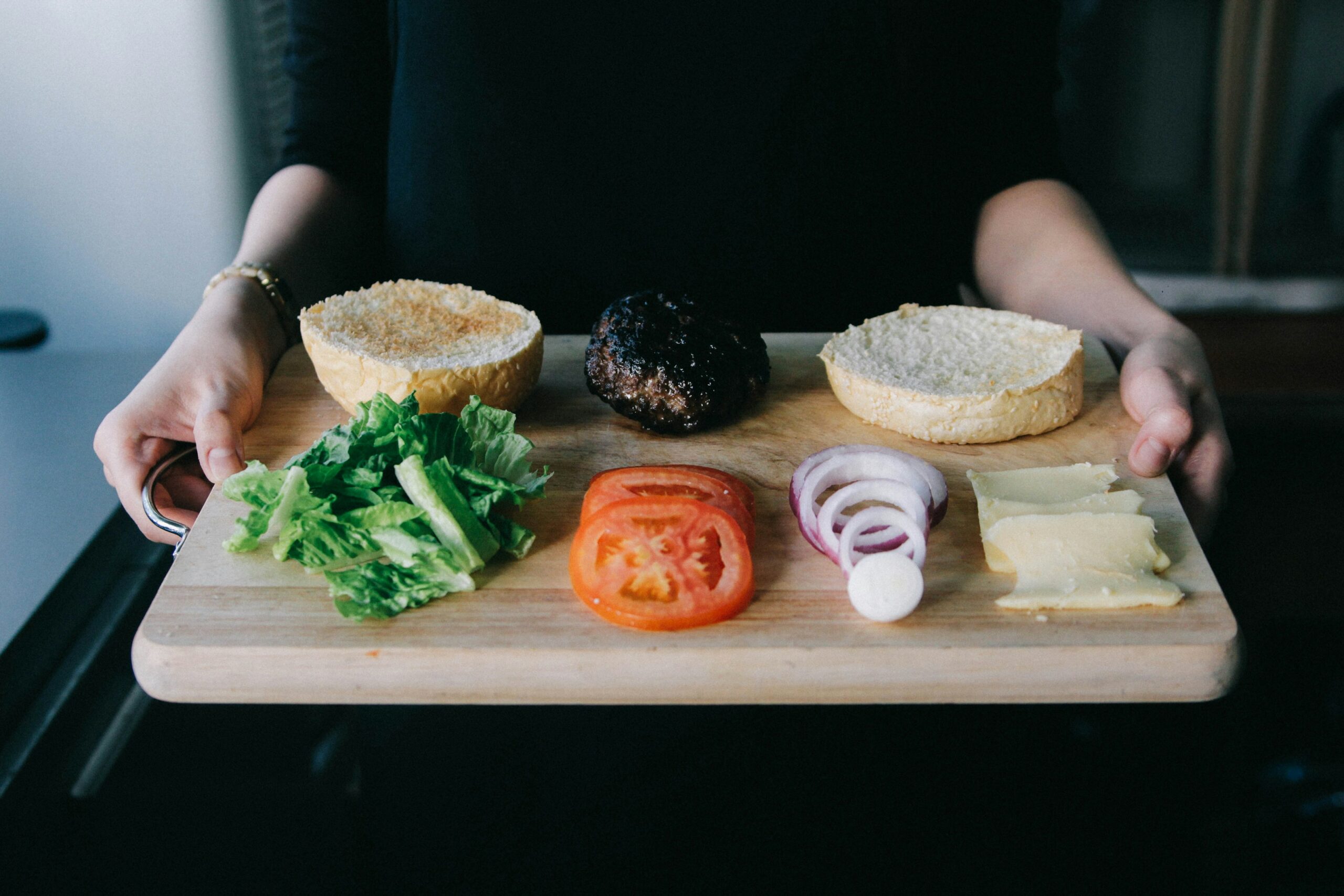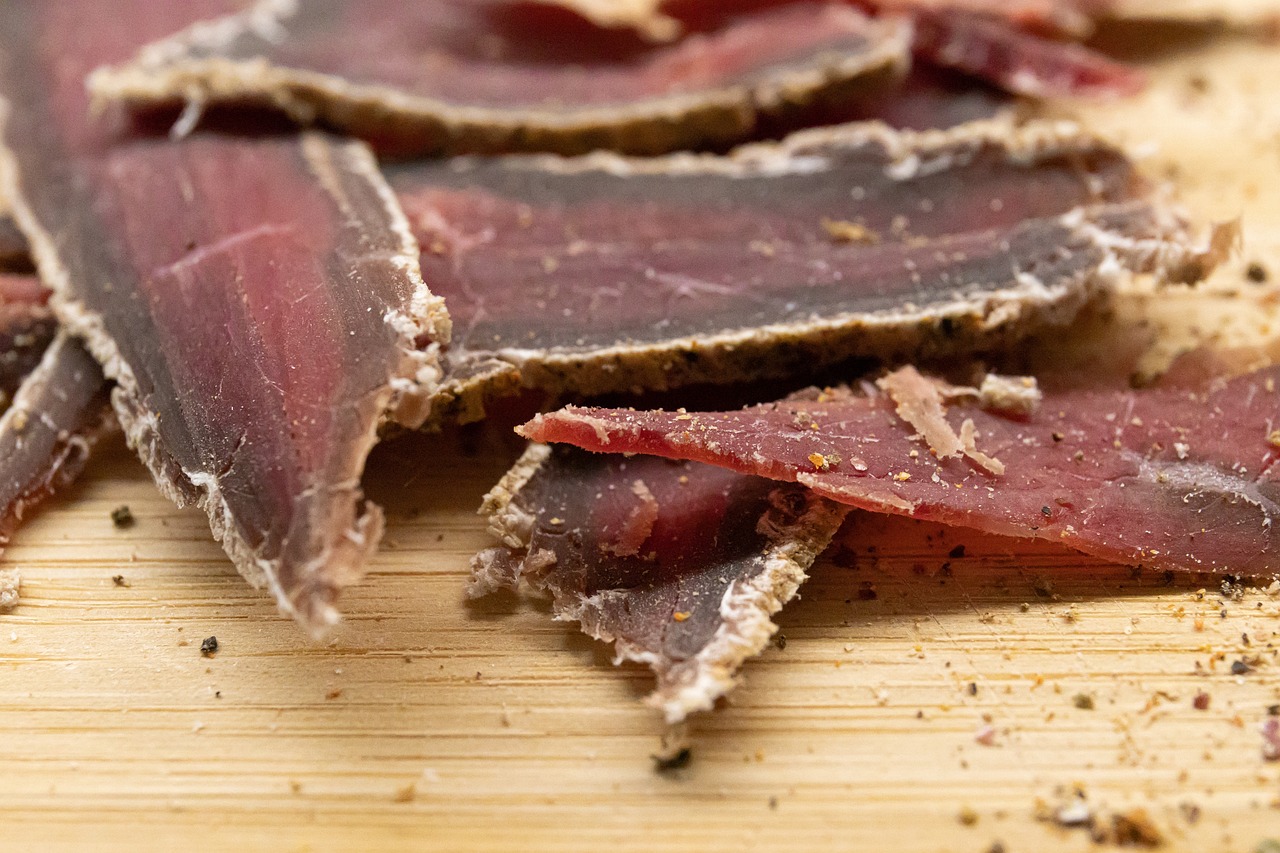Half a lifetime ago, I was at Bootlegger’s bar outside Gordon, WI, one of those timeless, one-room roadside rectangles with a vintage Harley nestled in one corner, felt-scuffed pool table in the other, dust-coated taxidermy on the walls (walleye; wolverine; six-point buck), and just one way in and one way out so the locals see you when you enter. And don’t park your pickup in the Ski-Doo spaces out back.
I was with college friends for a cabin bachelor party. After a few hours, another guy came in who recognized some of the gear we had on – Luther College, tennis players all – and he said, “Class of ‘86, boys!”
Then he asked another question – “Hey! Do you guys like jerky?”
We roared our approval and confirmed that we did. He sipped a beer, held up a finger, and ran out of the building. Thirty seconds later he returned with a huge and battered duffel bag and upended it over the bar, spilling scads of unmarked silver sealed packages all over the lacquered lumber.
“I work for Jack Link’s,” he said, settling back onto his stool after dumping the mother lode of sales samples all over the bar, “have some jerky.”
Big Flavor, Big Business…
Jerky is everywhere. You can find it in grocery aisles, gas stations, hobby shops, hardware stores and home improvement centers, and tempting hungry jetsetters in airports across the world. You can find it dangling in single-serve SKUs, stacked like matchsticks in plastic buckets near the register, sold in massive vacuum-sealed bags by the pound at the local bait shop. Sold in nuggets, sticks, and slabs, jerky products can be sealed, stashed, and stuffed into pockets, purses, bike and backpacks, vehicle consoles, literally anywhere. Jerky in any form has been a staple snack since navigators used sextets to sail the seven seas and discover more jerky, as John Smith is purported to have in the early 1600s when he marked a map of Virginia and wrote, “as drie as their jerkin beefe in the West Indies.”
So no wonder it’s a booming business. The meat snacks category is divided into jerky and meat sticks and comprises almost $3 billion annual sales; brands like Old Trapper, Tillamook, Oberto, Stryve, and Jack Link’s can be found across the country, and it’s estimated that over 1/3 of the American population (120 million+) enjoys beef jerky and meat snacks.
“Real beef jerky packs the highest ratio of protein and lowest sugar of just about any snack in existence,” said Robert Leary, chief marketing officer of Old Trapper, in an interview with The Food Institute. “Getting protein with a true amino acid profile and minimal ingredients is an extremely cost-effective way to get the best snack for you.”
Cost-effective is not just marketing talk; there’s real science behind the nutritional and economic value of jerky, as demonstrated by Hunter Thurman and Alpha-Diver’s recent webinar hosted by The Food Institute, where he broke down the top 50 snack brands via a novel psychological ranking of their perceived values. Consumers in the study cited Jack Link’s as one of the best snacking values in today’s market (Jack Link’s could not be reached for comment for this article).
Overall, Slim Jim ranked No. 21, Jack Link’s No. 26, and both companies comprised two of the top three “Instinctual Snacking” brands that consumers reach for when driven by a certain je ne sais quoi regarding protein munchies and feel-good snacking.
Or they may simply remember this gem from the 90s:
Did you know? Macho Man Randy Savage died after a heart attack and car accident in 2011, the same day the original manufacturing plant of Slim Jims shut down in Garner, NC.
Unlike some productions of Shakespeare, however, the jerky market is anything but boring. There are many notable jerky and meat snack companies out there and most are thriving as the snackification of America continues apace. Hershey recently sold its culinary snack brand, Krave, back to Sonoma Foods and CPG entrepreneur Jonathan Sebastiani, citing a different market go-to strategy was necessary. Sebastiani sold Krave to Hershey in 2015 for over $200 million. Sebastiani expects Krave to flourish under Sonoma and eventually become the alpha wolf in the highly competitive premium meat snacking category – a category that’s growing three times faster in the U.S. than regular jerky.
“There is still room for growth in the meat snacking space that we are excited to explore with upcoming innovation,” Sebastiani told Forbes in a recent interview, and he believes the growth of meat snacks won’t slow due to the ascendance of many plant-based options.
“Neither effort cannibalizes another, but rather opens up greater opportunity for entrepreneurs within this space,” he continued. Krave launched a plant-based jerky in January made with peas and fava beans to enter the estimated $3.5 billion alt-meat space.
One of the leaders in the alt-meat/jerky space agrees. “There has been a lot of interesting innovation in jerky over the past few years,” said Michael Pan, founder of Pan’s Mushroom Jerky. “Consumers are looking for ways to bring healthy snacks on-the-go, and it’s fun to see ways jerky is evolving with new ingredients…more people can enjoy jerky despite different dietary restrictions and preferences.”
Though this jerky consumer will stay mostly on the beef-derived side of the SKU, many consumers enjoy both or favor alt-meat options like Pan’s due to health and nutrition needs and concerns.
“Whether you’re vegan, plant-forward, or a carnivore, our products can be enjoyed by all,” he said. (Pan started his company in 2018, later appeared on Shark Tank, finished 2020 with over $2 million in sales as a CPG startup, and scaled up as demand increased; more details can be seen here).
The breadth and scale of jerky options is staggering, and though consumers benefit from a wealth of flavors, textures, ingredients, and nutritional benefits, most companies don’t have the option to produce completely different plant- or beef-derived products; what’s more, most don’t want to.
…And Big, Big Competition
“Jerky companies are very private in their process of cooking and preservation,” said Holly and Curtis Mackley, owners of Mingua Beef Jerky, a traditional jerky company of 30 years out of Paris, KY.
“It is dog-eat-dog out there. We will be looking at the possibility of offering a new flavor or maybe meat sticks; the jerky scene is always evolving. We will continue to cook and distribute our jerky as we have for years.” (Mingua also offers dog-friendly jerky treats; premium pet food and treats is another exploding category.)
The fierce competition for the jerky market is a sentiment echoed by Leary and Old Trapper. “[Old Trapper] doesn’t really pay attention to non-meat jerky brands because they really aren’t even the same thing and the customers are definitely not the same people,” Leary mused.
“They can definitely co-exist, but it is a very expensive way to pay for something that is not beef, so only time will tell if their customers stay loyal over the long haul like ours have, but yes, we do believe neo- and traditional jerky can co-exist. Regardless of their choice of meat or non-meat, providing a high-quality, delicious product has the best likelihood of developing a loyal customer. Beyond this, the market is really hungry for brands to communicate honestly and simply and this is something we always strive for and that our customers appreciate.”
Leary anticipates further growth for Old Trapper and, broadly speaking, for the entire jerky category. “The shelf-stable snacks demand is forecasted to only increase and the desire for high-quality protein at a lower sugar amount tracks with this increase in demand.”
Longtime jerky consumers know the snack is generally quite healthy; everything in moderation, yes, but there’s a lot more sugar-loaded gut bombs and empty calories to reach for at the checkout counter than the dried and cured meat option vacuum-sealed in a bag. As health and wellness continue to drive almost every food and snacking category, companies like Fruit Slabs are taking advantage, competing for elbow room in the jerky space and poised between flavor and fun, satisfaction and satiety.
“As far as jerky fans go, the market is definitely going to keep growing, and I am excited to see the proliferation of new flavor combos,” said Brandon Dorsky, founder of Fruit Slabs, “the unofficial edible of the apocalypse,” who cites spicy fruit jerky and jerky with toppings (coconut flakes, anyone?) as exciting innovations in the space.
Fruit Slabs are infused, dehydrated jerky alternatives sold as kosher-certified fruit leathers. Non-infused samples are available, but the company’s bread and butter (jerk and flavor?) are CBD- and THC-infused snacks made from organic fruit purees with no added sugar or artificial ingredients; each SKU has five ingredients or less, with 100 calories or less in the entire package and 10 calories or less per serving. They’re also vegan and peanut- and gluten-free.
Dorsky is thrilled about the growth of the better-for-you segment. “The greatest opportunity for Fruit Slabs is to enter states that are [legalizing CBD and THC products] and the potentiality for alternative versions of our products featuring nootropics, adaptogens, mushrooms, and other plant extracts,” he told The Food Institute. “We’re not really in the same lane as Jack Link’s or Old Trapper,” he told The Food Institute, “and we’re strictly pushing organic fruit products for now. I believe part of the appeal of Fruit Slabs is that we are a pretty wholesome, all-natural product. Our products are safe for all diets and dietary restrictions.”
So there it is. From traditional and longtime jerky brands to mushroom and health-forward alternatives, jerky is absolutely thriving in today’s market. Whether stopping for gas at some backwoods C-store or browsing the Mall of America and popping into The Beef Jerky Experience – one of the fastest-growing franchises in America – there’s something for everyone. As spring rolls into summer, I hope you find something to sink your teeth into.












